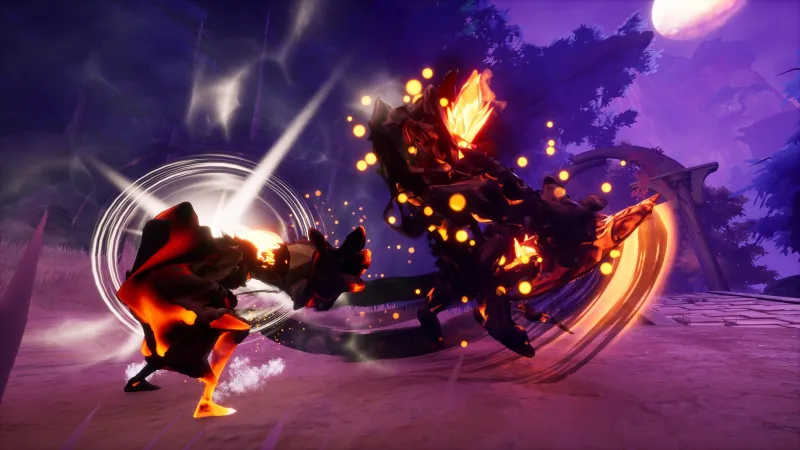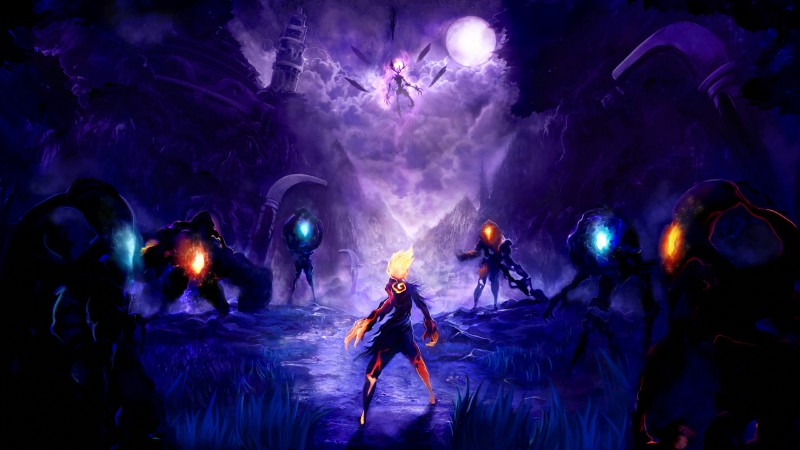It’s rare for me to have something new to offer in action combat. In games that feature this, you’re using either a gun to kill enemies or melee actions to take them down, and I often can’t help but wonder how it can work. Of course, I may fall in love with the familiar combat in spite of it, but it’s always exciting to experience something I haven’t done before, which is exactly what Stride Lights manages to do.
Relying almost exclusively on a unique parry system that requires you to switch between two colors to match your enemy’s attack, I couldn’t get enough of Stray Lights’ action, even if it was repetitive . that the combat was wrapped in a gorgeous, realized alien world and supported by a dynamic and musically diverse score by Austin Wintory (composer of Journey and pathless) Improve your time with the game.
Stride Lights begins with a birth of sorts. You begin as a spark of light – an ember – on a journey to transcendence. To succeed, you’ll need to confront your inner demons – the Darkness – using a defense-focused combat style, while exploring more of this ethereal sci-fi world to learn of its existence. In my first hour, I felt overwhelmed because developer Embers does little to hold your hand or even guide you in a direction, but the game’s openness is more linear than before.
Running in this world is great, but the platforming is less than stellar at times. Jumping feels awkward because your character often bangs on the ground, and you have to wait a few moments for them to recover and stand back up. This design choice makes big leaps, which many have, feel burdensome. But the platforming is hardly the star of the show so much as a quick means of getting to the next battle zone.
When an enemy is close, a shadowy substance smears the sides of the screen, a rocky monster (sometimes two) appears, and stray lights begin to glow. By pressing the left bumper, I can change the color of the bright light burning inside my character from blue to orange and back. It’s important to finish the game as soon as it starts because every enemy changes color in this way. And you need to coordinate with the right bumper that matches your colour. This mechanic starts off simple, but a third color you can’t match – purple – gets thrown into the mix, requiring you to dodge. At its height, a fourth color is added and enemies quickly switch between them as they lash out at you with three, four and sometimes five hits. I loved crazily changing my colors to parry to match his colors, dodging when necessary, and hitting with my limited offensive abilities.
Parrying is the only way to regenerate health during combat, which made me play more dangerously as my health dropped. There are abilities and special moves you can unlock for your combat repertoire but ultimately, learning the Stride Lights’ parry mechanic is key – you can’t get to the end if you can’t time it right. I love a good parry in a game and this one was satisfying to the end, but those who prefer to dodge in a melee action game may struggle.

Collecting pieces from enemies to spend on abilities is satisfying, as is exploring open areas to collect lore-related items, leveling up, and more. Luckily, finding these collectibles requires little effort to stray from the path, which is good because it lets you get back into battle. The action is simple but satisfying, and the instances where I had to fight more than one enemy at a time were more frustrating than anything, yet I enjoyed almost every combat scenario I stumbled into.
The game however lacks enemy variety. Initially it felt like each new area might have its own enemy makeup, but halfway through the game, I realized that there were only a handful of monsters in Strayed Lights that could be thrown at me. Learning each attack pattern was a fun mental exercise, and I would have liked more.
No matter what I was doing, my eyes and ears were feasting. I entered each newly opened area in Strayed Lights, delighted by the visual design before me. The sun and moon burn overhead, and the landscape is painted in beautiful shades of green, blue, neon pinks, and purple. My ember light of a character shines brightly against these backgrounds and my hard drive is home to dozens of screenshots because of it. Wintry’s score matches the tone of each venue, dancing between ethereal wind instruments and ritualistic poses that seem to be speaking their own alien language. Even when the gameplay falters, like in two-enemy combat scenarios or the game’s less-than-great platforming, I enjoyed being in this world thanks to Strayed Lights’ score and visual design.
The Stride Lights is short, sweet, and excels at what most players ask it to do. Its unique parry-required combat brings something new to the table, and I enjoyed almost every instance of it, especially the big boss-fight setpieces sprinkled through the journey. Its exploration doesn’t require much effort, which is a good thing since it doesn’t feel great to platform through massive areas. It’s easy to brush aside its omission, though, as it’s a joy to watch and listen to throughout the game. Stride Lights is a strong debut from Embers in almost every way and serves to highlight the importance of the game’s foundation. At its core, Stray Lights revolves around a simple, intuitive, and unique combat system, and with a premise this strong, it’s no wonder the game shines as bright as it does.
